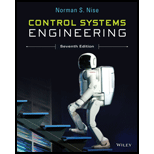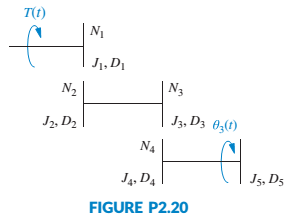
Control Systems Engineering
7th Edition
ISBN: 9781118170519
Author: Norman S. Nise
Publisher: WILEY
expand_more
expand_more
format_list_bulleted
Concept explainers
Textbook Question
thumb_up100%
Chapter 2, Problem 35P
For the rotational

Expert Solution & Answer
Trending nowThis is a popular solution!

Students have asked these similar questions
2. A kilogram mass is attached to the end of the spring with spring constant 2 N/m. Find the equation of motion if
the mass is initially released (set in motion) from rest from a point 1 meter above equilibrium position. (Use the
convention that displacements measured below the equilibrium position are positive.)
(a) Write the initial-value problem which describes the position of the mass.
(b) Find the solution to your initial-value problem from part (a).
(c) Graph the solution found in (b) on (0
6. The electro-mechanical system shown below consists of an electric motor with input
voltage V which drives inertia I in the mechanical system (see torque T). Find the
governing differential equations of motion for this electro-mechanical system in
terms of the input voltage to the motor and output displacement y.
Electrical System
puthiy
C
V
V₁
R
bac
(0)
T
bac
T
Motor
- Motor Input Voltage
- Motor Back EMF = Kbac (
- Motor Angular Velocity
- Motor Output Torque = K₂ i
Kbacs K₁ - Motor Constants
Mechanical System
M
T
Frictionless Support
1. Write the mathematical equations for the mechanical rotational system given. Also find the transfer
function (s)/T(s) of the given system.
#
(Torque applied)
J₂
voooooo
J₂
Chapter 2 Solutions
Control Systems Engineering
Ch. 2 - Prob. 1RQCh. 2 - Prob. 2RQCh. 2 - Prob. 3RQCh. 2 - Define the transfer function.Ch. 2 - Prob. 5RQCh. 2 - What do we call the mechanical equations written...Ch. 2 - If we understand the form the mechanical equations...Ch. 2 - Why do transfer functions for mechanical networks...Ch. 2 - What function do gears perform?Ch. 2 - What are the component parts of the mechanical...
Ch. 2 - The motor’s transfer function relates armature...Ch. 2 - Summarize the steps taken to linearize a nonlinear...Ch. 2 - Prob. 1PCh. 2 - Prob. 2PCh. 2 - Prob. 3PCh. 2 - Prob. 4PCh. 2 - Prob. 5PCh. 2 - Prob. 6PCh. 2 - Prob. 7PCh. 2 - A system is described by the following...Ch. 2 - For each of the following transfer functions,...Ch. 2 - Write the differential equation for the system...Ch. 2 - Write the differential equation that is...Ch. 2 - Prob. 12PCh. 2 - Use MATLAB to generate the MATLAB ML transfer...Ch. 2 - Repeat Problem 13 for the MATLAB following...Ch. 2 - Use MATLAB to generate the partial fraction...Ch. 2 - Use MATLAB and the Symbolic Math Symbolic Math...Ch. 2 - Prob. 17PCh. 2 - Prob. 18PCh. 2 - Prob. 19PCh. 2 - Repeat Problem 19 using nodal equations. [Section:...Ch. 2 - Prob. 22PCh. 2 - Prob. 23PCh. 2 - Prob. 24PCh. 2 - Prob. 25PCh. 2 - Prob. 26PCh. 2 - Prob. 27PCh. 2 - Prob. 28PCh. 2 - Prob. 29PCh. 2 - Write, but do not solve, the equations of motion...Ch. 2 - For the unexcited (no external force applied)...Ch. 2 - For each of the rotational mechanical systems...Ch. 2 - For the rotational mechanical system shown in...Ch. 2 - Find the transfer function, 1sTs , for the system...Ch. 2 - For the rotational mechanical system with gears...Ch. 2 - For the rotational system shown in Figure P2.21,...Ch. 2 - Prob. 37PCh. 2 - Find the transfer function, Gs=4s/Ts , for the...Ch. 2 - For the rotational system shown in Figure P2.24,...Ch. 2 - Prob. 40PCh. 2 - Given the rotational system shown in Figure P226,...Ch. 2 - In the system shown in Figure P2.27, the inertia,...Ch. 2 - Prob. 43PCh. 2 - Given the combined translational and rotational...Ch. 2 - Prob. 45PCh. 2 - The motor whose torque-speed characteristics are...Ch. 2 - A dc motor develops 55 N-m of torque at a speed of...Ch. 2 - 48. In this chapter, we derived the transfer...Ch. 2 - Prob. 49PCh. 2 - Find the series and parallel analogs for the...Ch. 2 - Find the series and parallel analogs for the...Ch. 2 - A system’s output, c, is related to the system’s...Ch. 2 - Prob. 53PCh. 2 - Consider the differential equation...Ch. 2 - 55. Many systems are piecewise linear. That is,...Ch. 2 - For the translational mechanical system with a...Ch. 2 - 57. Enzymes are large proteins that biological...Ch. 2 - Prob. 58PCh. 2 - Figure P2.36 shows a crane hoisting a load....Ch. 2 - 60. In 1978, Malthus developed a model for human...Ch. 2 - 61. In order to design an underwater vehicle that...Ch. 2 - 62. The Gompertz growth model is commonly used to...Ch. 2 - A muscle hanging from a beam is shown in Figure...Ch. 2 - A three-phase ac/dc converter supplies dc to a...Ch. 2 - Prob. 65P
Knowledge Booster
Learn more about
Need a deep-dive on the concept behind this application? Look no further. Learn more about this topic, mechanical-engineering and related others by exploring similar questions and additional content below.Similar questions
- Find the transfer function 8,(s) / T(s) of the given mechanical network below. Show your complete solution on a clean sheet of paper. I should see the following • List of torques exerted in tabular form ( • Clearly stated equations ( • Solution on how to find the transfer function from these equations IN-m/rad T) 02(1) for f I kg-m2 IN-m-s/rad I N-m-s/rad I N-m-s/radarrow_forwardFigure Q3 shows one cart with a mass that is separated from two walls by two springs and a dashpot, where kı, k2 and ka are the first, second spring and dashpot coefficients, respectively. The mass, m could represent an automobile system. An external force is also shown as F(t). Only horizontal motion and forces are considered. F(t) is input and x2(t) is output. (a) Derive all equations related to the system (b) Construct the block diagram from equation in (a) (c) Obtain the transfer function of the systemarrow_forward2. (25) For the rotational system shown in the fig- ure, write the equations of motion from which the transfer function, G(s) = 01(8)/T(s), can be found.arrow_forward
- 1 An object of mass 125 kg is released from rest from a boat into the water and allowed to sink. While gravity is pulling the object down, a buoyancy force of times the weight of the object is pushing the object up (weight = mg). If we assume that water 40 resistance exerts a force on the object that is proportional to the velocity of the object, with proportionality constant 10 N-sec/m, find the equation of motion of the object. After how many seconds will the velocity of the object be 90 m/sec? Assume that the acceleration due to gravity is 9.81 m/ sec2. Find the equation of motion of the object. X(t) = %3Darrow_forwardFind the differential equation of the mechanical system in Figure 1(a) To obtain the differential equation of motion of the mass and spring system given in Fig. 1. (a) one may utilize the Newton's law for mass and spring relations defined as shown in Fig. 1. (b) and (c) use f = cv for viscous friction, where v is the velocity of the motion and c is a constant. Z/////// k M F. F, F F F, F, k EF=ma F = k(x, - x,) = kx (b) (c) Figure 1: Mass-spring system (a), Force relations of mass (b) and spring (c)arrow_forwarda. For the translational mechanical system shown in Figure (3). 1. Write the mathematical model in a format of matrices. 2. Find the transfer function G(s) = a₁ (s)/T (s) where a is the acceleration. t 45²² +16,5 245+628²-2-05+96 M₁ = 8 kg 6 N-s/m f(t) 1 N/m 0000 4 N-s/m -x₂(1) M₂-3kg Frictionless 0000 15 N/m Frictionless Figure (3) Translational mechanical systemarrow_forward
- Chapter 07, Problem 027 Z Your answer is partially correct. Try again. A spring and block are in the arrangement of the figure. When the block is pulled out to x = +4.0 cm, we must apply a force of magnitude 370N to hold it there. We pull the block to x = 11.0 cm and then release it. How much work does the spring do on the block when the block moves from x, = +5.0 cm to (a) x = +4.0 cm, (b) x = -4.0 cm, (c) x= -5.0 cm, and (d) x = -10.0 cm? x=0 Block F= 0 attached elleeee to spring (a) x positive F, negative (b) ugen/shared/assignment/test/aglist.uni?id=.. x negative 9:34 PM search A ENG 4/4/2021 ASUS 13) 1ghome f10 snd 17 4 7. 00 16 3.arrow_forwardGet the equation of motion by drawing the free body diagram of the given systems. a) Get the system's transfer function and find the unit digit answer. Show all decals in detail. m = 1 kg b= 20 Ns/m k = 125 N/m F ww k b) get the transfer function of the system. X(s)/Pg(s) =? Show all decals in detail. resistance R k Pg massless piston area (A) capacitancearrow_forwardPleasearrow_forward
- ll b) Obtain the mathematical model of the system shown in Figure Q2b using Newton's second law of motion, F=ma. k₁ w 3- 777777 C1 7771 k₂ D 7777 Figure: Q2b Page 2 of 7 A C2 1112arrow_forwardJ 1. Using Lagrangian mechanics, derive the equations of motion of a cart with two tires under the cart shown in Figure P.4.1.arrow_forward4. The pitch (angular motion) and bounce (up-down linear motion) of a motor vehicle is shown in Figure Q4. Write down the two equations of motion of the vehicle and hence find its frequency equation. (a) (b) Assume that the mass of the vehicle is 1,000 kg, radius of gyration is 0.9 m, spring stiffnesses kr = 18 kN/m and kr = 22 kN/m, distances Iı = 1.0 m and l2 = 1.5 m, determine the two natural frequencies and mode shapes of the system. Bounce Pitch C.G.I Figure Q4arrow_forward
arrow_back_ios
SEE MORE QUESTIONS
arrow_forward_ios
Recommended textbooks for you
 Elements Of ElectromagneticsMechanical EngineeringISBN:9780190698614Author:Sadiku, Matthew N. O.Publisher:Oxford University Press
Elements Of ElectromagneticsMechanical EngineeringISBN:9780190698614Author:Sadiku, Matthew N. O.Publisher:Oxford University Press Mechanics of Materials (10th Edition)Mechanical EngineeringISBN:9780134319650Author:Russell C. HibbelerPublisher:PEARSON
Mechanics of Materials (10th Edition)Mechanical EngineeringISBN:9780134319650Author:Russell C. HibbelerPublisher:PEARSON Thermodynamics: An Engineering ApproachMechanical EngineeringISBN:9781259822674Author:Yunus A. Cengel Dr., Michael A. BolesPublisher:McGraw-Hill Education
Thermodynamics: An Engineering ApproachMechanical EngineeringISBN:9781259822674Author:Yunus A. Cengel Dr., Michael A. BolesPublisher:McGraw-Hill Education Control Systems EngineeringMechanical EngineeringISBN:9781118170519Author:Norman S. NisePublisher:WILEY
Control Systems EngineeringMechanical EngineeringISBN:9781118170519Author:Norman S. NisePublisher:WILEY Mechanics of Materials (MindTap Course List)Mechanical EngineeringISBN:9781337093347Author:Barry J. Goodno, James M. GerePublisher:Cengage Learning
Mechanics of Materials (MindTap Course List)Mechanical EngineeringISBN:9781337093347Author:Barry J. Goodno, James M. GerePublisher:Cengage Learning Engineering Mechanics: StaticsMechanical EngineeringISBN:9781118807330Author:James L. Meriam, L. G. Kraige, J. N. BoltonPublisher:WILEY
Engineering Mechanics: StaticsMechanical EngineeringISBN:9781118807330Author:James L. Meriam, L. G. Kraige, J. N. BoltonPublisher:WILEY

Elements Of Electromagnetics
Mechanical Engineering
ISBN:9780190698614
Author:Sadiku, Matthew N. O.
Publisher:Oxford University Press

Mechanics of Materials (10th Edition)
Mechanical Engineering
ISBN:9780134319650
Author:Russell C. Hibbeler
Publisher:PEARSON

Thermodynamics: An Engineering Approach
Mechanical Engineering
ISBN:9781259822674
Author:Yunus A. Cengel Dr., Michael A. Boles
Publisher:McGraw-Hill Education

Control Systems Engineering
Mechanical Engineering
ISBN:9781118170519
Author:Norman S. Nise
Publisher:WILEY

Mechanics of Materials (MindTap Course List)
Mechanical Engineering
ISBN:9781337093347
Author:Barry J. Goodno, James M. Gere
Publisher:Cengage Learning

Engineering Mechanics: Statics
Mechanical Engineering
ISBN:9781118807330
Author:James L. Meriam, L. G. Kraige, J. N. Bolton
Publisher:WILEY
Ch 2 - 2.2.2 Forced Undamped Oscillation; Author: Benjamin Drew;https://www.youtube.com/watch?v=6Tb7Rx-bCWE;License: Standard youtube license